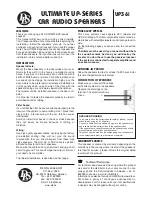
176
10.2. Connecting devices via the optical connection
You can connect digital amplifiers or televisions via the OPTICAL connection. To do
this, you will need an optical digital cable (fibre optic cable, not supplied with the
soundbar, but available from specialist retailers).
Set the volume on the audio device to a medium level.
Then switch it off.
Remove the protective cap from the optical connector.
Insert the plug in the OPTICAL socket on the soundbar.
Insert the plug in the corresponding digital output socket on your digital receiv-
er or television.
If no sound is output, switch the audio output format on your output
device to PCM (Pulse Code Modulation) mode.
10.3. Connecting devices via HDMI (ARC)
You will need an HDMI cable. The HDMI cable is not supplied.
Set the volume on the audio device to a medium level.
Then switch it off.
Insert the HDMI connector in the HDMI IN socket on your television.
Enable the ARC and CEC functions and switch the sound output to PCM on the
devices connected to the soundbar.
Comply with the user manuals for the devices connected to the soundbar.
If two devices are connected, using ARC means not only that audio signals are re-
ceived via HDMI, but that these signals can also be sent back along the same cable.
Using CEC (Consumer Electronics Control), all the devices connected via HDMI can
communicate with each other. This connection then means you can use the remote
control to adjust the volume on the television, or mute it.
ARC only works for devices that are HDMI ARC-enabled and have an
HDMI 1.4 cable (and higher).
11. Setting up a Bluetooth connection
Using Bluetooth, you can receive audio signals wirelessly from an external Blue-
tooth-enabled audio output device. Make sure the two devices are not more than 8
metres apart.
44202 ML Content MSN 5006 5063 Final Rev2.indb 176
44202 ML Content MSN 5006 5063 Final Rev2.indb 176
15.06.2020 11:21:33
15.06.2020 11:21:33











































